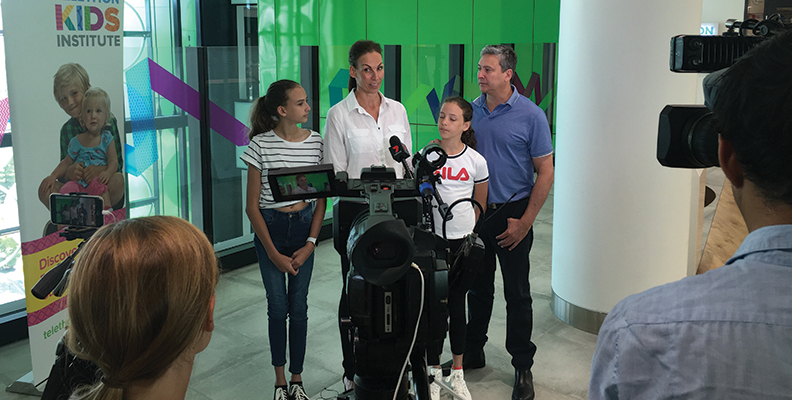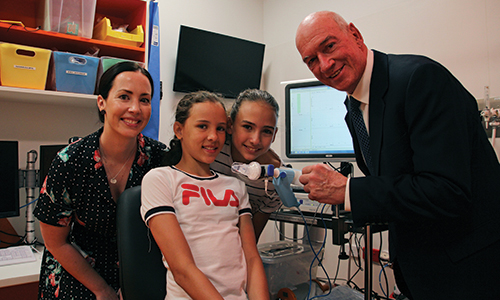
The Donaldson family at the Respirion launch
The family of two girls with cystic fibrosis are hopeful after Telethon Kids Institute spin-off company, Respirion, received $20 million in funding to develop a promising new therapy.
Isobel, born three weeks early, had been failing to gain weight and after a series of tests, doctors told Christine and husband Gerard that she had CF, a genetic condition that causes persistent lung infections and progressive lung damage.
“I was devastated,” Christine said. “When you’re pregnant with your child, you have this idea of how great their life will be, and when you’re given this CF diagnosis, there’s such an incredible grieving process that their life might be hard, or their life might be limited.”
Two years after Isobel was born, the Donaldsons welcomed their fourth child and second daughter, Ruby. Soon after, they received the devastating news that Ruby also had CF.
“In the early days it was me coming to term with the diagnoses emotionally because the girls were relatively healthy,” Christine said.
CF causes the lungs to produce abnormally thick and sticky mucus, trapping bacteria and leading to recurrent infections which can cause permanent damage and result in lung failure.
Since birth, Isobel and Ruby have received constant medical treatment and physiotherapy to keep their lungs healthy, but antibiotic resistance means they are desperately in need of new treatments to fight off constant infections.
“You’re always wondering what’s going on under the skin. They look so healthy on the outside. Any cough I hear them do, in the back of my head, I’m wondering where that’s going and what damage it’s causing,” Christine said.
Now, a new therapy being developed by Telethon Kids spin-off company Respirion could provide new hope for kids like Isobel and Ruby.
The treatment – a chemical added to an inhaled antibiotic therapy – is the brainchild of leading Australian pulmonary specialist, and Respirion Founder and Director, Dr Barry Clements.
“Persistent lung infections and the inevitable decline in lung function remain urgent unmet needs in cystic fibrosis,” Dr Clements said.
“In my 35 years treating cystic fibrosis, I’ve become increasingly frustrated with the limited effectiveness of antibiotics in treating lung infections.
“With no new antibiotics on the horizon, I found this chemical that weakened the defences of resistant bacteria in the laboratory.
“I took this chemical and combined it with an antibiotic (tobramycin) and found it increased the killing power of the antibiotic on these resistant germs, but also improved the patient’s overall lung function.”

Now, thanks to a $20 million investment from the Medical Research Commercialisation Fund’s Biomedical Translation Fund (MRCF BTF), and $4 million from the US Cystic Fibrosis Foundation, Respirion will take the therapy into larger clinical studies, in the hope it will one day soon be available to patients.
Dr Clements said the ultimate aim was to reduce infections, reduce hospitalisations, and improve the quality of life and life expectancy in these patients.
Although further testing and statutory approval are required, if the results continue to be positive the formulation could be ready for clinical use in as little as four years.
“At that stage, there will be opportunities to further explore the potential of this formulation for use against other micro-organisms (including fungae and TB), with different antibiotics, and for treating other diseases such as non-CF bronchiectasis,” Dr Clements said.
Christine was thrilled at the news, saying the prospect of increased lung function was fantastic.
“That’s going to give our girls longevity and hopefully keep them out of hospital so they can just enjoy being kids,” she said.
What's next
-
The formulation will undergo further clinical trials over the next 12-24 months to establish safety and stability sufficient to obtain regulatory approval for clinical use in humans.
-
Pending that approval, the definitive multi-centre Phase 3 efficacy study will be performed and if the results prove positive, the formulation will then be ready for use in the clinic.
